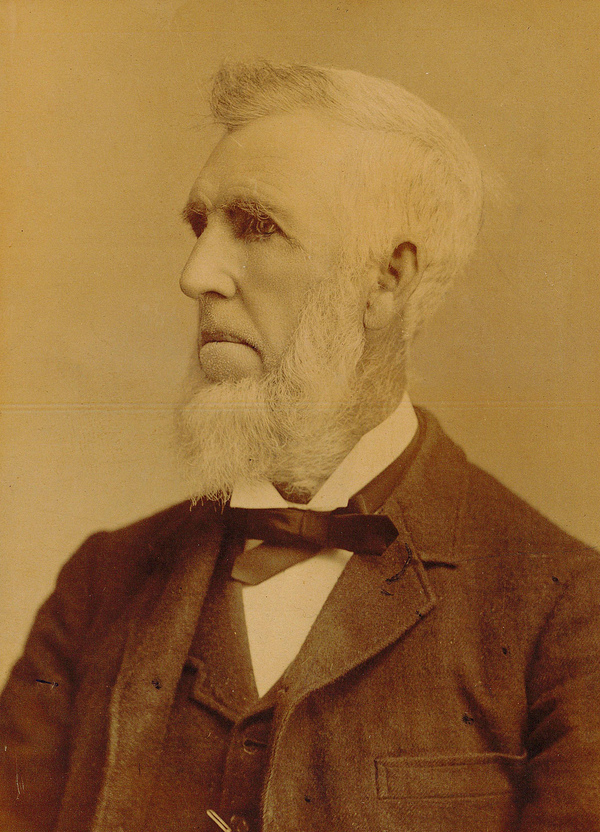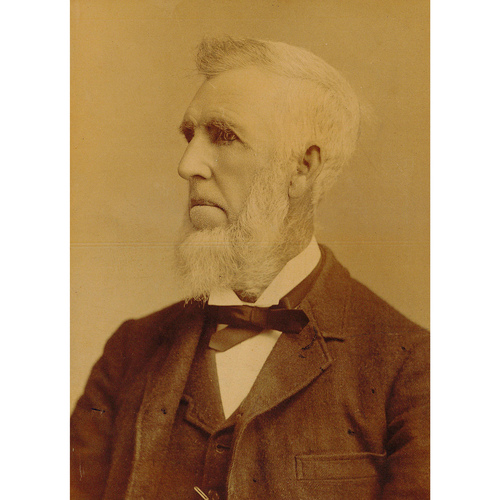
Source: Link
TILLSON, EDWIN DELEVAN, businessman, politician, magistrate, office holder, and stockbreeder; b. 26 March 1825 in Normandale, Upper Canada, sixth of the nine children of George Tillson* and Nancy Barker; m. 4 July 1850 in Tilsonburg (Tillsonburg), Upper Canada, Mary Ann Van Norman, daughter of Joseph Van Norman*, and they had four sons and three daughters; d. near there 31 Jan. 1902.
In 1822 George Tillson moved from western New York to become part owner of an ironworks at Normandale, in Norfolk County. About three years later the family moved to Dereham (Southwest Oxford) Township, where Tillson’s foundry and mills spurred the growth of a settlement, known from the 1830s as Tilsonburg. For about seven months in 1845 Edwin Delevan Tillson attended Norwalk Academy, south of Cleveland, Ohio, a liberal-arts college founded by the Methodist Episcopal Church. He subsequently taught school for three months in the Dobbie settlement in Bayham Township, Ohio. This endeavour, he later recalled, provided him with the $36 that served as the principal for his first commercial investment.
Upon his return to Tilsonburg, Tillson used this money to enter into a partnership with Wright Barker and Charles Cody. Gaining water-privileges on Clear Creek from George Tillson in 1846, they constructed a sawmill, doing most of the work themselves. Through this venture E. D. Tillson acquired enough capital to build a second sawmill, with his father, in 1851; seven years later he bought the elder Tillson’s mills and water-rights. According to the 1861 census he was operating a sawmill, a grist-mill, a planing mill, a sash-and-door factory, and a store. Following George Tillson’s death in 1864, he acquired from the estate a large portion of his father’s remaining property.
In the 1860s there was a marked shift away from lumber-milling in the economic base of Tillson’s work and Tilsonburg’s interests. The large amount of land cleared and the agricultural endeavours of the area, in response to American demand during the Civil War period, stimulated the development of diverse milling opportunities. This situation allowed Tillson to expand his operations and, beginning in 1865, to construct an oat-mill and a pea-mill. As well, he adopted technological advances in milling: his grist-milling operation was converted from millstones to rollers, and between 1885 and 1886 the general balance of its accounts grew from $3,319.12 to $8,391.75.
In the sphere of milling and agricultural produce, Tillson will be best remembered for the development and marketing of the patented Tillson Pan-Dried Oats. According to his son Edwin Van Norman, a doctor had recommended that Tillson Sr eat oatmeal after his recovery from typhoid, but to obtain the food staple locally he had to build his own mill. This mill, constructed in 1873, produced 125 barrels of rolled oatmeal per day by traditional methods. After 1878 it was replaced following a fire by a larger structure, which incorporated Tillson’s patented method of dry-kiln preparation. This innovation, though more costly than steam drying, greatly improved the processing and palatability of the oatmeal. A marketing campaign that promoted “A Food, not a Fad” sold the Scottish staple as “just good plain, wholesome Canadian oatmeal porridge.” In the face of growing competition from new, ready-cooked cereals, the combination of product and marketing made Tillson’s oatmeal internationally known. Producing upwards of 200 barrels a day, the new mill shipped to such places as the United Kingdom, Germany, and Norway. After 1882 this and other of Tillson’s mills operated under the name of the Tillson Company, directed by his sons, Edwin, Fred Bloomfield, and George Whiting. Tillson Sr nevertheless retained some interest: in 1890, for instance, he formed a railway company to build a spur, evidently between the mills and a divisional line of the Great Western.
Apart from the mills, Tillson was extensively involved in the growth of Tilsonburg. George Tillson may be considered its founder, but E. D. was its early leader. The memorial booklet published at his death reviews his significance to the community. It was Tillson who initiated the town’s incorporation in 1872 and he was its first mayor. In addition, he served as a reeve of Dereham Township and was a magistrate and for over 30 years postmaster of Tilsonburg. He personally orchestrated the construction of the town’s waterworks system and first high school, and the levelling of its streets. Tillson was a staunch Conservative, an ardent supporter of temperance, and an active member of the local Methodist church.
Tillson’s focus shifted somewhat around 1882 to what would be his final achievement, Annandale, his model farm near Tilsonburg. So well constructed and managed was this scientific operation that it was compared to the Ontario Agricultural College in Guelph. It incorporated the most modern of techniques, from silos and underground ventilation to the selective breeding of Holstein cattle and the sterilization of dairy and meat-processing buildings. These features, mixed with Tilson’s fastidious business practices, drew admiring attention from agricultural associations and journals such as the Farmer’s Advocate and Home Magazine (London) and the Canadian Grocer (Toronto).
Tillson took ill at Annandale on 29 Jan. 1902 and a physician was brought to the home. After surgery he showed signs of recovery, but he died on the 31st. He was outlived by his wife and five children. The church bells tolled and flags in Tilsonburg flew at half-mast to mourn his passing. Following in his father’s footsteps, E. D. Tillson, by successfully modernizing his interests to meet the needs of a growing society, epitomized the prominent Canadian industrialists of the late 19th century.
Extensive records relating to Edwin Delevan Tillson’s life are on file at his Tillsonburg, Ont., residence, which is now administered by the Tillsonburg and Dist. Hist. Museum Soc., and known as Tillsonburg Museum and Annandale House.
NA, RG 31, C1, 1851, 1861, 1871, Dereham Township. Oxford Land Registry Office (Woodstock, Ont.), Dereham Township, abstract index to deeds and deeds for concessions 11–12, lots 1–4 (mfm. at AO). Farmer’s Advocate and Home Magazine, 15 Feb. 1902. Tilsonburg Liberal (Tilsonburg [Tillsonburg]), 6 Feb. 1902. L. A. Beechey, “E. D. and Mary Ann Tillson’s Annandale House” ([Tillsonburg], 1990); “E. D. Tillson: Annandale Farm” (1987); “E. D. Tillson’s other business” (1988); “E. D. Tillson’s real estate” (1988); “The mills” (1987); and “Tillson family homes” (1989) [Tillsonburg and Dist. Hist. Museum Soc. booklets, available at the museum]. Canadian album (Cochrane and Hopkins), vol.1. Canadian biog. dict. J. I. Cooper, Earliest Tillsonburg (Tillsonburg, [1981]); also unpublished essays on the history of the town prepared for the Tillsonburg and Dist. Hist. Museum Soc., 1972–84, available at the museum. J. I.Cooper and John Armstrong, Tillsonburg: a history, 1825–1982 (Tillsonburg, 1984). In memoriam: Edwin Delevan Tillson (Tilsonburg, 1902; copy in Tillsonburg Museum, Reference files, 84.18.01). A. F. Marquette, Brands, trademarks and good will: the story of the Quaker Oats Company (New York, 1967). E. D. Tillson, Record of George and Nancy Tillson’s family . . . (Tilsonburg, [1889]; repr. Tillsonburg, 1973; copy in the museum). Topographical and historical atlas of Oxford, Ontario (Toronto, 1876), repr. as Illustrated historical atlas of Oxford County, Ontario (Belleville, Ont., 1972).
Cite This Article
Bruce Richard, “TILLSON, EDWIN DELEVAN,” in Dictionary of Canadian Biography, vol. 13, University of Toronto/Université Laval, 2003–, accessed January 19, 2026, https://www.biographi.ca/en/bio/tillson_edwin_delevan_13E.html.
The citation above shows the format for footnotes and endnotes according to the Chicago manual of style (16th edition). Information to be used in other citation formats:
| Permalink: | https://www.biographi.ca/en/bio/tillson_edwin_delevan_13E.html |
| Author of Article: | Bruce Richard |
| Title of Article: | TILLSON, EDWIN DELEVAN |
| Publication Name: | Dictionary of Canadian Biography, vol. 13 |
| Publisher: | University of Toronto/Université Laval |
| Year of publication: | 1994 |
| Year of revision: | 1994 |
| Access Date: | January 19, 2026 |



